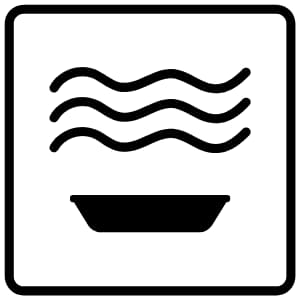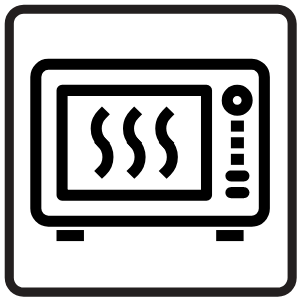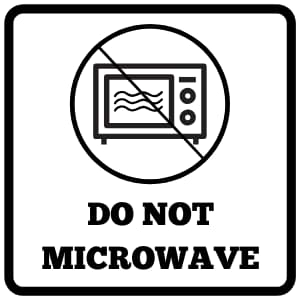What Does a Microwave-Safe Symbol Look Like?
If you’re wondering whether a container is safe to place inside the microwave, you have to look for a microwave safe symbol.
Don’t know what that looks like?
Read on.

What is a microwave safe symbol?
Here’s a list of the most common microwave-safe symbols. Different brands might have slight variations, but in general they look like this:
Microwave safe symbol #1:

Microwave safe symbol #2:

Microwave safe symbol #3:

Microwave safe symbol #4:

Now you know what to look for at the bottom of a container before placing it inside the microwave (learn how to find the dishwasher-safe symbol on an item in this post).
Some containers are the opposite of microwave-safe: microwaving the container might damage the container or your microwave, or might release harmful substances into your food.
So what does a “non-microwave-safe symbol” look like?
Non-microwave-safe symbol
If you find any of these symbols on a container, it means it is NOT safe for the microwave:
Non-microwave-safe symbol #1:

Non-microwave-safe symbol #2:

But here’s the tricky part: what if an item doesn’t come with any symbols at all?
Just keep reading, cause we’ve prepared a list of kitchen items that are simply not microwave safe.
Things you should never put in the microwave
Now that you know all about the symbols for microwave safe items, let’s look at what containers should never ever be put into the microwave.
1. Can you put aluminum foil in the microwave?
According to the Food and Drug Administration (FDA), you should never place any food that’s inside or covered with aluminum foil into the microwave.
If you do, it will cause sparks and flames, possibly ruining the microwave, and perhaps even setting the building on fire.
Here’s a video of what can happen when you do this:
This means that aluminum foil is not safe to use in the microwave when reheating your dinner.
2. Can you place metal in the microwave?
What goes for aluminum foil goes for all types of metal.
The question of exactly how much havoc a metallic item can wreak inside your microwave depends on two things: the shape of the metal, and the length of time it’s left inside an operating microwave.
You can learn about the physics behind this by watching this video:
3. Is styrofoam microwavable?
Styrofoam is made from polystyrene.
Polystyrene melts degrades when exposed to heat, such as in a microwave.
This video shows what a styrofoam plate looks like after it’s been exposed to the heat inside a microwave:
That’s a problem because polystyrene contains styrene (a possible carcinogen) and a neurotoxin called benzene.
When polystyrene gets hot and degrades, it releases all those dangerous compounds into your food.
The take-home point: styrofoam is not microwave safe.
4. Can you microwave plastic tupperware or takeout container?
Many plastic containers come with numbers at the bottom that allow you to figure out what type of plastic they are made of.
While some types of plastic are safer than others, it’s best to avoid reheating your food in plastic containers, if you can help it.
Here’s why.
Before a plastic container is deemed as microwave safe and is granted a microwave safe symbol, numerous tests are conducted to measure the amount of chemicals that leech from the plastic into the food.
Scientists then estimate how long an average user will heat the container, how often it will be heated, and how hot the food inside the container will get.
Then they conduct animal tests to find out how many chemical make it into the food and from there into the body.
If the amount of toxins doesn’t pass a certain threshold, the material is deemed as “safe”.
This means that even plastic containers that carry the “microwave-safe” symbol will expose you to a certain amount of those chemicals.
These chemicals are especially dangerous to children, affecting the development of their brains.
Learn more about the American Association of Pediatrics’s findings about putting plastic in the microwave (and in the dishwasher) in this short video:
In so many words, plastic is not microwave-safe, even if it comes with a microwave-safe symbol.
Containers that ARE microwave-safe
So what materials are microwave-safe, and won’t leech toxins into your snack? Check out these options:
1. Ceramic (without metallic decorations) – for example, these ceramic bowls, plates, and cups are microwave-safe (and also dishwasher safe).
2. Glass. For example, these glass food-storage containers are safe in the microwave (and dishwasher- and freezer-safe, too).
These items give you peace of mind: when you place them in the microwave, they will neither catch fire nor leach toxins into your food.
And if you’d like to keep those non-toxic dishes truly safe, why not wash them with the most natural dish soap there is?
Now you’re a microwave-safe-symbol pro!
Now that you’ve learned the basic facts about microwavability, take your knowledge to the next level.
Learn about items you should never place inside a dishwasher in the next post.
And if you feel like you’ve learned a thing or two, be sure to share this post with friends!
(When you make a purchase from links in this post we might receive a small commission at no additional cost to you.)

Back to News